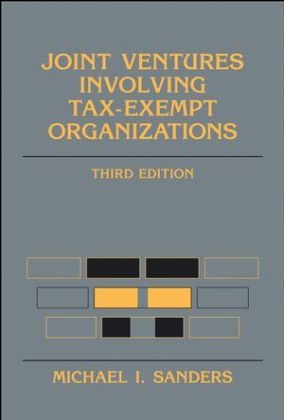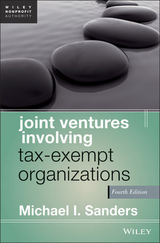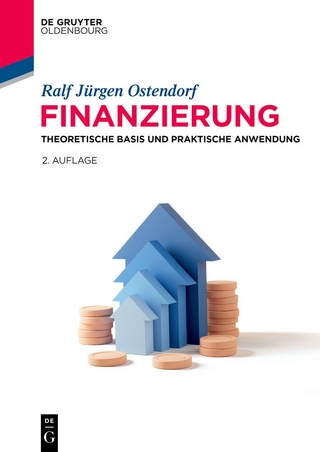
Joint Ventures Involving Tax-exempt Organizations
John Wiley & Sons Ltd (Verlag)
978-0-470-03761-4 (ISBN)
- Titel erscheint in neuer Auflage
- Artikel merken
Michael I. Sanders, Partner at Blank Rome LLP, focuses his practice in the area of taxation, offering particular expertise in matters affecting partnerships, limited liability companies, S-corporations, real estate and tax controversy. He also has a large practice in the area of exempt organizations involving health care and low-income housing, associations and joint ventures between for-profits and non-profits, as well as structuring New Markets Tax Credit transactions. He regularly serves as an expert witness in complex litigation. Mr. Sanders was named by the Washington Business Journal as one of the City's Top Ten Lawyers and the City's Top Tax Lawyer in 2004. Additionally, he was presented the Israel Bonds Legal and Financial Division's Light of Jerusalem Award in November of 2005. He was honored as one of "Washington, DC's Legal Elite" by Smart CEO Magazine for 2006 and 2007. In 2007, he was selected from a field of the nation's leading lawyers and judges as a finalist for the Lawdragon 500 based upon his current impact on the biggest issues and deals in the law. He was also recognized by Washingtonian magazine as "One of Washington's Top Lawyers" for 2007 and 2008. Mr. Sanders is the author of Joint Ventures Involving Tax-Exempt Organizations (3rd Edition) published by John Wiley & Sons, Inc. He is also an adjunct professor at George Washington University Law Center and Georgetown University Law School teaching Income Taxation of Partnerships and Subchapter S Corporations and Tax Treatment of Charities and Other Non-Profit Organizations, Joint Ventures Involving Tax Exempt Organizations (including healthcare, universities, LIHTC, new markets, conservation organizations, respectively. Previously, Mr. Sanders served as an Attorney-Advisor to the Assistant Secretary of Tax Policy at the Office of Tax Legislative Counsel and as a Trial Attorney at the U.S. Department of Justice (Attorney General's Honors Program).
Acknowledgments. Preface. Chapter one: Introduction: Joint Ventures Involving Exempt Organizations Generally. 1.1 Introduction. 1.2 Joint Ventures in General. 1.3 Healthcare Joint Ventures. 1.4 University Joint Ventures. 1.5 Low-Income Housing Joint Ventures. 1.6 Conservation Joint Ventures. 1.7 Joint Ventures as Accomodating Parties to Impermissible Tax Shelters. 1.8 Joint Venture Structure. 1.9 The Exempt Organization in a Joint Venture: Rev. Rul. 98-15. 1.10 Ancillary Joint Ventures: Rev. Rul. 2004-51. 1.11 The Exempt Organization as Limited Partner or Non-Managing Member. 1.12 Partnerships with Other Exempt Organizations. 1.13 Transfer of Control of Supporting Organization to Another Tax-Exempt Organization. 1.14 The Exempt Organization as a Lender or Ground Lessor. 1.15 Partnership Taxation. 1.16 UBIT Implications From Partnership Activities. 1.17 Use of a Subsidiary as Participant in a Joint Venture. 1.18 Limitation on Preferred Returns. 1.19 Sharing Staff and/or Facilities: Shared Services Agreement. 1.20 "Intangibles" Licensed by Nonprofit to For-Profit Subsidiary or Joint Venture. 1.21 Private Inurement and Private Benefit. 1.22 Limitation on Private Foundation's Activities that Limit Excess Business Holdings. 1.23 International Joint Ventures. 1.24 Other Developments. Chapter Two: Taxation of Charitable Organizations. 2.1 Introduction. 2.2 Categories of Exempt Organizations. 2.3 Section 501(c) Organizations: Structural Elements. 2.4 Statutory Requirements. 2.5 General Requirements. 2.6 Charitable Organizations. 2.7 Structure of the IRS. 2.8 Application for Exemption. 2.9 Reporting Requirements. 2.10 The IRS Audit. 2.11 Charitable Contributions. 2.12 Car Donation Programs. 2.13 Sarbanes-Oxley and Exempt Organizations. 2.14 State Laws. Chapter Three: Taxation of Partnerships and Joint Ventures. 3.1 Scope of Chapter. 3.2 Qualifying as a Partnership. 3.3 Classification as Partnership. 3.4 Alternatives to Partnerships. 3.5 Pass-Through Regime: The Conduit Concept. 3.6 Allocation of Profits, Losses, and Credits. 3.7 Formation of Partnership. 3.8 Tax Basis in Partnership Interests. 3.9 Partnership Operations. 3.10 Partnership Distributions to Partners. 3.11 Sale or Other Disposition of Assets or Interests. 3.12 Other Tax Issues. Chapter Four: Overview: Joint Ventures Involving Exempt Organizations. 4.1 Introduction. 4.2 Exempt Organization as General Partner: A Historical Perspective. 4.3 Exempt Organizations as Limited Partner or LLC Non-Managing Member. 4.4 Joint Ventures with Other Exempt Organizations. 4.5 New Scheme for Analyzing Joint Ventures. 4.6 Revenue Ruling 2004-51 and Ancillary Joint Ventures. 4.7 UBIT Implications from Joint Venture Activities. 4.8 Use of a Subsidiary as Participant in a Joint Venture. 4.9 Use of a Supporting Organization in a Joint Venture. 4.10 The IRS Audit. 4.11 Conversions from Exempt to For-Profit and from For-Profit to Exempt Entities. 4.12 Exempt Organization as Lender or Ground Lessor. 4.13 Issuance of Tax-Exempt Bonds. 4.14 Reporting Requirements. Appendix 4A Joint Venture Checklist. Chapter Five: Private Benefit, Private Inurement, and Excess Benefit Transactions. 5.1 What are Private Inurement and Private Benefit? 5.2 Transactions in which Private Benefit or Inurement May Occur. 5.3 Profit-Making Activities as Indicia of Nonexempt Purpose. 5.4 Intermediate Sanctions. 5.5 Case Law. 5.6 Planning. 5.7 State Activity with Respect to Insider Transactions. Chapter Six: The Exempt Organization as Lender or Ground Lessor. 6.1 Overview. 6.2 A Participation as a Lender or Ground Lessor. 6.3 Types of Real Estate Loans. 6.4 Participating Loans. 6.5 Ground Lease with Leasehold Mortgage. 6.6 Sale of Undeveloped Land. 6.7 Guarantees. 6.8 Conclusion. Chapter Seven: Exempt Organizations as Accommodating Parties in Tax Shelter Transactions. 7.1 Introduction. 7.2 Prevention of Abusive Tax Shelters. 7.3 Excise Taxes and Penalties. 7.4 Settlement Initiatives. 7.5 Abusive Shelters and Tax Credit Programs. Chapter Eight: The Unrelated Business Income Tax. 8.1 Introduction. 8.2 Historical and Legislative Background of UBIT. 8.3 General Rule. 8.4 Statutory Exceptions to UBIT. 8.5 Modifications to UBIT. 8.6 Income from Partnerships. 8.7 Calculation of UBIT. 8.8 Governmental Scrutiny and Legislative Initiatives. Chapter Nine: Debt-Financed Income. 9.1 Introduction. 9.2 Debt-Financed Property. 9.3 The 514(c)(9) Exception. 9.4 Partnership Rules. 9.5 The Fractions Rule. 9.6 The Final Regulation. 9.7 The Fractions Rule: A Trap for The Unwary. Chapter Ten: Limitation on Excess Business Holdings. 10.1 Introduction. 10.2 Excess Business Holdings: General Rules. 10.3 Tax Imposed. 10.4 Exclusions. Chapter Eleven: Impact on Taxable Joint Ventures: Tax-Exempt Entity Leasing Rules. 11.1 Introduction. 11.2 Types of Transactions Covered by 1984 Act Rules. 11.3 Internal Revenue Code 168(h). 11.4 Tax-Exempt Use Property. 11.5 Restrictions on Tax-Exempt Use Property. 11.6 Partnership Rules. Chapter Twelve: Healthcare Entities in Joint Ventures. 12.1 Overview of Economics. 12.2 Classifications of Joint Ventures. 12.3 Tax Analysis. 12.4 Other Healthcare Industry Issues. 12.5 Preserving the 50/50 Joint Venture. 12.6 Valuation. 12.7 Joint Operating Agreements. 12.8 UBIT Implications of Hospital Joint Ventures. 12.9 Government Scrutiny. 12.10 Precautionary Steps: A Road Map. 12.11 Conclusion. Appendix 12A Sample Conflicts of Interest Policy. Chapter Thirteen: Low-Income Housing-New Markets, Rehabilitation, and Other Tax Credits Programs. 13.1 Relationships Between Nonprofits and For-Profits in Affordable Housing-A Basic Business Typology. 13.2 Low-Income Housing Tax Credit. 13.3 Historic Investment Tax Credit. 13.4 Empowerment Zone Tax Incentives. 13.5 New Markets Tax Credits. 13.6 Recent IRS Guidance Regarding Guarantees and Indemnifications. 13.7 Reportable LIHTC/NMTC Transactions. 13.8 Gulf Zone Opportunity Act of 2005. Appendix 13A New Markets Tax Credits Project Compliance/Qualification Checklist. Chapter Fourteen: Joint Ventures with Universities. 14.1 Introduction. 14.2 IRS Focus on Universities. 14.3 Special Statutory UBIT Rule. 14.4 Research Joint Ventures Generally. 14.5 Faculty Participation in Research Joint Ventures. 14.6 Nonresearch Joint Venture Arrangements. 14.7 Modes of Participation by Universities in Joint Ventures. 14.8 Incentives Available to Taxable Joint Venturers. 14.9 Conclusion. Chapter Fifteen: Business Leagues Engaged in Joint Ventures. 15.1 Overview. 15.2 The Five-Prong Test. 15.3 Unrelated Business Income Tax. 15.4 Corporate Sponsorship. Chapter Sixteen: Conservation Organizations in Joint Ventures. 16.1 Overview. 16.2 Conservation and Environmental Protection as a Charitable or Educational Purpose: Public and Private Benefit. 16.3 Conservation Gifts and 170(h) Contributions. 16.4 Unrelated Business Income Tax Issues. 16.5 Joint Ventures Involving Conservation Organizations and For-Profit Participants. 16.6 Senate Finance Committee Investigation of the Nature Conservancy (TNC). 16.7 Emerging Issues. 16.8 Conclusion. Chapter Seventeen: International Joint Ventures. 17.1 Overview. 17.2 Domestic Charities Expending Funds Abroad. 17.3 Potential for Abuse: The Use of Charities as Accommodating Parties In International Terrorist Activities. 17.4 Guidelines for U.S.-Based Charities Engaging in International Aid and International Charities. 17.5 General Grant-making Rules. 17.6 Foreign Organizations Recognized by the IRS as 501(c)(3) Organizations. 17.7 Public Charity Equivalency Test. 17.8 Expenditure Responsibility. 17.9 Domestic Charities Entering into Joint Ventures with Foreign Organizations. 17.10 Application of Foreign Laws In Operating a Joint Venture in a Foreign Country. 17.11 Application of Foreign Tax Treaties. 17.12 Current Developments in Cross-Border Charitable Activities. 17.13 Conclusions and Forecast. Chapter Eighteen: Private Pension Fund Investments in Joint Ventures. 18.1 Overview. 18.2 Private Pension Fund Participation in Joint Ventures. 18.3 Conclusion. Chapter Nineteen: Exempt Organizations Investing Through Limited Liability Companies. 19.1 Introduction. 19.2 The Basics of LLCs: State and Federal Income Tax Law. 19.3 Comparison with Other Business Entities. 19.4 Background and Development of LLCs. 19.5 Tax Classification of LLCs Under Check-the-Box Regulations. 19.6 Exempt Organizations Wholly Owning Other Entities. 19.7 IRS Analysis: The Double-Prong Test and Rev. Rul. 98-15. 19.8 Nonprofit-Sponsored LIHTC Project. 19.9 Private Foundations as Members of LLCs. Chapter Twenty: Debt Restructuring and Asset Protection Issues. 20.1 Introduction. 20.2 Overview of Bankruptcy. 20.3 Automatic Stay. 20.4 Chapter 11 Plan of Reorganization. 20.5 Discharge. 20.6 Special Issues: Use of Cash. 20.7 Special Issues: Consequences of Debt Reduction. Index.
| Erscheint lt. Verlag | 11.5.2007 |
|---|---|
| Reihe/Serie | Wiley Nonprofit Law, Finance, and Management Series |
| Zusatzinfo | Illustrations |
| Verlagsort | Chichester |
| Sprache | englisch |
| Maße | 185 x 253 mm |
| Gewicht | 1760 g |
| Einbandart | gebunden |
| Themenwelt | Wirtschaft ► Betriebswirtschaft / Management ► Finanzierung |
| ISBN-10 | 0-470-03761-X / 047003761X |
| ISBN-13 | 978-0-470-03761-4 / 9780470037614 |
| Zustand | Neuware |
| Informationen gemäß Produktsicherheitsverordnung (GPSR) | |
| Haben Sie eine Frage zum Produkt? |
aus dem Bereich



